I understand the nomenclature of the phi and the psi angles of the alpha-Carbon atoms in protein stucture, but I am confused by the Ramachandran plot. Each alpha-Carbon atom (magenta) makes two peptide linkages and has two corresponding neighbouring alpha-Carbons (cyan) and side-chains. I would expect the psi and phi values to depend on the interactions of these side-chains, so I would expect that for a single amino acid one would need a separate graph for every possible combination of neighbouring amino acids.
I am not clear whether this the case. The following graph (1) from Harper, Biochemistry, is for “many non-glycine residues from many proteins”. So, suppose a set of phi and psi is allowed for a right-handed helix (a value or data set taken from the plot) does it mean that it is allowed for any amino acid with any other amino acid? I woud expect an alanine adacent to an alanine to have a different interaction to an alanine adjacent to a bulky amino acid such as isoleucine.
I have also seen plots for specific amino acid and their allowed angles, such as that for proline (2), above. This suggests that the neighbours are not being taken into account. If this is so, why not?
Answer
The phi and psi dihedrals describe the dihedral on both sides of the c-alpha of a single amino acid, and do not involve any angles of the neighboring amino acid.
The Ramachandran plot is something generated from a set of protein structures, an empirical data set. The top graph represents the dihedrals found for all non-glycine residues in a set of structures. You can filter this for proline only, and you'd get the bottom graph. The top cloud of dihedrals represents those found in beta-sheets, and the bottom cloud those for alpha-helices. Sequence (the amino acid before or after) doesn't really matter that much for what's allowed (although we cannot directly deduce this from the data in those graphs).
If you look a little bit more into the structure of helices and sheets you'll also find out why that's the case. In beta sheets the sidechain of the +1 residue is pointing completely the other way, and also in helices there's little interaction between the sidechains of subsequent residues. Secondary structures are built using the amides, not with the sidechains.


No comments:
Post a Comment